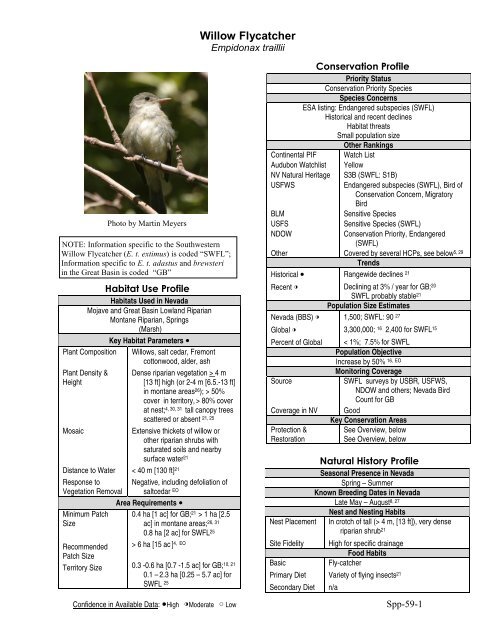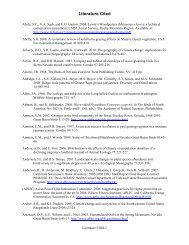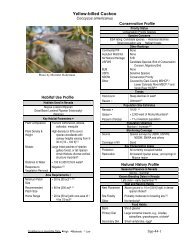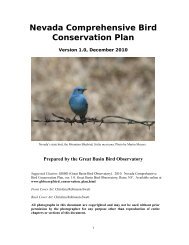Willow Flycatcher - Great Basin Bird Observatory
Willow Flycatcher - Great Basin Bird Observatory
Willow Flycatcher - Great Basin Bird Observatory
You also want an ePaper? Increase the reach of your titles
YUMPU automatically turns print PDFs into web optimized ePapers that Google loves.
Photo by Martin Meyers<br />
NOTE: Information specific to the Southwestern<br />
<strong>Willow</strong> <strong>Flycatcher</strong> (E. t. extimus) is coded “SWFL”;<br />
Information specific to E. t. adastus and brewsteri<br />
in the <strong>Great</strong> <strong>Basin</strong> is coded “GB”<br />
Habitat Use Profile<br />
Habitats Used in Nevada<br />
Mojave and <strong>Great</strong> <strong>Basin</strong> Lowland Riparian<br />
Montane Riparian, Springs<br />
(Marsh)<br />
Key Habitat Parameters ●<br />
Plant Composition<br />
Plant Density &<br />
Height<br />
Mosaic<br />
Distance to Water<br />
Response to<br />
Vegetation Removal<br />
Minimum Patch<br />
Size<br />
Recommended<br />
Patch Size<br />
Territory Size<br />
<strong>Willow</strong>s, salt cedar, Fremont<br />
cottonwood, alder, ash<br />
Dense riparian vegetation > 4 m<br />
[13 ft] high (or 2-4 m [6.5.-13 ft]<br />
in montane areas26 ); > 50%<br />
cover in territory, > 80% cover<br />
at nest; 4, 30, 31 tall canopy trees<br />
scattered or absent 21, 25<br />
Extensive thickets of willow or<br />
other riparian shrubs with<br />
saturated soils and nearby<br />
surface water21 < 40 m [130 ft] 21<br />
Negative, including defoliation of<br />
saltcedar EO<br />
Area Requirements ●<br />
0.4 ha [1 ac] for GB; 21 > 1 ha [2.5<br />
ac] in montane areas; 26, 31<br />
0.8 ha [2 ac] for SWFL25 > 6 ha [15 ac ] 4, EO<br />
0.3 -0.6 ha [0.7 -1.5 ac] for GB; 10, 21<br />
0.1 – 2.3 ha [0.25 – 5.7 ac] for<br />
SWFL 25<br />
<strong>Willow</strong> <strong>Flycatcher</strong><br />
Empidonax traillii<br />
Continental PIF<br />
Audubon Watchlist<br />
NV Natural Heritage<br />
USFWS<br />
BLM<br />
USFS<br />
NDOW<br />
Nest Placement<br />
Site Fidelity<br />
Natural History Profile<br />
Seasonal Presence in Nevada<br />
Spring – Summer<br />
Known Breeding Dates in Nevada<br />
Late May – August8, 27<br />
Nest and Nesting Habits<br />
In crotch of tall (> 4 m, [13 ft]), very dense<br />
riparian shrub 21<br />
High for specific drainage<br />
Food Habits<br />
Fly-catcher<br />
Confidence in Available Data: ●High ◑Moderate ○ Low Spp-59-1<br />
Other<br />
Historical ●<br />
Recent ◑<br />
Nevada (BBS) ◑<br />
Global ◑<br />
Percent of Global<br />
Source<br />
Coverage in NV<br />
Protection &<br />
Restoration<br />
Basic<br />
Primary Diet<br />
Secondary Diet<br />
Conservation Profile<br />
Priority Status<br />
Conservation Priority Species<br />
Species Concerns<br />
ESA listing: Endangered subspecies (SWFL)<br />
Historical and recent declines<br />
Habitat threats<br />
Small population size<br />
Variety of flying insects 21<br />
n/a<br />
Other Rankings<br />
Watch List<br />
Yellow<br />
S3B (SWFL: S1B)<br />
Endangered subspecies (SWFL), <strong>Bird</strong> of<br />
Conservation Concern, Migratory<br />
<strong>Bird</strong><br />
Sensitive Species<br />
Sensitive Species (SWFL)<br />
Conservation Priority, Endangered<br />
(SWFL)<br />
Covered by several HCPs, see below5, 29<br />
Trends<br />
Rangewide declines 21<br />
Declining at 3% / year for GB; 20<br />
SWFL probably stable21 Population Size Estimates<br />
1,500; SWFL: 90 27<br />
3,300,000; 16 2,400 for SWFL 15<br />
< 1%; 7.5% for SWFL<br />
Population Objective<br />
Increase by 50% 16, EO<br />
Monitoring Coverage<br />
SWFL surveys by USBR, USFWS,<br />
NDOW and others; Nevada <strong>Bird</strong><br />
Count for GB<br />
Good<br />
Key Conservation Areas<br />
See Overview, below<br />
See Overview, below
<strong>Willow</strong> <strong>Flycatcher</strong><br />
Empidonax traillii<br />
E .t. adastus and E .t. brewsteri<br />
Spp-59-2
<strong>Willow</strong> <strong>Flycatcher</strong><br />
Empidonax traillii<br />
E .t. extimus<br />
Spp-59-3
<strong>Willow</strong> <strong>Flycatcher</strong><br />
Empidonax traillii<br />
Overview<br />
Although fairly common in states to the north and east of Nevada, the <strong>Willow</strong> <strong>Flycatcher</strong><br />
is far less abundant in the arid West, where much of its historical riparian habitat has<br />
been lost or degraded. 16 Three subspecies breed in Nevada: the endangered Southwestern<br />
<strong>Willow</strong> <strong>Flycatcher</strong>, E. t. extimus (SWFL) in the Mojave region along the Colorado,<br />
Virgin, and Muddy Rivers, and in the Meadow Valley Wash, Pahranagat Valley, and Ash<br />
Meadows NWR 14,27 ; E .t. adastus throughout the <strong>Great</strong> <strong>Basin</strong> portion of Nevada in small<br />
numbers 2 ; and E. t. adastus may be replaced in far-western Nevada by E. t. brewsteri,<br />
from which it is difficult to distinguish. 10 NBC data show that in far-western Nevada,<br />
<strong>Willow</strong> <strong>Flycatcher</strong>s are primarily found in montane riparian habitat, with some spillover<br />
into lowland riparian areas. In central, eastern, and northern Nevada, the rare E. t. adastus<br />
is found in both lowland and montane riparian habitats, and occasionally in other<br />
inundated areas such as aspen stands or wet meadows. All three subspecies use the lower<br />
Colorado River corridor during migration. 30<br />
Because of its listing under the ESA, SWFL has been intensively studied, and detailed<br />
recovery strategies have been developed. 30 E. t. brewsteri in the Sierra Nevada has also<br />
been studied in some depth. 4, 10, 26 However, there have been no studies in Nevada of the<br />
increasingly rare E .t. adastus subspecies, despite the substantial declines it has suffered<br />
over recent decades. Consequently, the <strong>Great</strong> <strong>Basin</strong> lowland populations of <strong>Willow</strong><br />
<strong>Flycatcher</strong> receive little conservation attention.<br />
All three <strong>Willow</strong> <strong>Flycatcher</strong> subspecies are riparian-obligates and have undergone large<br />
historical declines because of the widespread loss of dense, shrubby riparian habitat with<br />
water-saturated soils. <strong>Willow</strong> <strong>Flycatcher</strong>s were common in the Sierra Nevada until 1910,<br />
and at least locally abundant through 1940, with noticeable declines occurring after<br />
1950. 15 In recent surveys, birds were absent from 53 of 135 previously known sites, 10 and<br />
there may now be only 300-400 individuals left in the entire Sierra Nevada, 10, 26 with only<br />
a small fraction of these in our state. <strong>Willow</strong> <strong>Flycatcher</strong>s in Nevada’s <strong>Great</strong> <strong>Basin</strong> have<br />
become exceedingly rare in recent decades, and historical data from the lower Truckee<br />
River indicate that the species was considered abundant in the late 1800s, but is absent as<br />
a breeder today. 1 Similar declines almost certainly occurred along other <strong>Great</strong> <strong>Basin</strong><br />
rivers as well, and remaining populations are small and fragmented. 6,10<br />
<strong>Willow</strong> <strong>Flycatcher</strong>s breed in tall dense shrubs, and in most studies, occupancy and<br />
nesting success is related to shrub cover and volume. 4,15,22 <strong>Willow</strong>s are the traditionally<br />
preferred vegetation, 25 but other shrub species are also used, although riparian mesquite<br />
bosques are usually avoided (except in Ash Meadows NWR). 30 The SWFL will readily<br />
nest in saltcedar stands, as long as they are sufficiently tall and dense. About 25% of all<br />
known SWFL breeding territories are now located at sites dominated by salt cedar, 24 and<br />
intensive studies in Arizona have found no apparent drop in any measure of foraging or<br />
nesting success for birds nesting in saltcedar stands. 15 Cover of overstory trees is variable<br />
across occupied sites, but they are generally only scattered and often absent. All<br />
Spp-59-4
<strong>Willow</strong> <strong>Flycatcher</strong><br />
Empidonax traillii<br />
subspecies are tied to wet areas (standing water or highly saturated soils), 10 and the<br />
SWFL is particularly dependent on the presence of permanent surface water. 30 For<br />
example, a severe drought in 2002 may have completely eliminated SWFL reproduction<br />
in some areas. 15 Heterogeneity of vegetation structure may be an important factor in<br />
determining habitat suitability, 15 as large patches of riparian shrubs without interspersed<br />
openings are often avoided. 10,31 <strong>Willow</strong> <strong>Flycatcher</strong>s can breed in very small patches (0.1<br />
ha [0.25 ac]), 10,31 but aggregations of suitable patches promote healthy population<br />
dynamics. Individuals will readily move among patches within a drainage, sometimes up<br />
to 30-40 km [19-25 mi]. 15 The width and continuity of the riparian vegetation can also be<br />
important. 19,22 Narrow strips < 10 m [33 ft] wide are generally not occupied. 30<br />
Most threats to <strong>Willow</strong> <strong>Flycatcher</strong>s and lowland riparian habitats have been welldocumented<br />
(see Main Threats and Challenges, below). 30 Threats to montane populations<br />
are less well-studied, but probably center upon the dewatering of riparian or meadow<br />
patches as a result of water diversions, or lowering of local water tables (and the<br />
consequent impacts on riparian shrubs) b y gully erosion from heavy livestock use, road<br />
building, or natural runoff events. 10 Cowbird parasitism is low in montane populations,<br />
but it can be problematic in lowland populations, and has been a major concern for<br />
SWFL. 33 Cowbird trapping has been shown to increase the local reproductive output of<br />
SWFL in the short-term, but it is not clear that it has benefits to long-term population<br />
recovery. Trapping is therefore an expensive and short-term solution recommended only<br />
in emergencies. 17<br />
The SWFL currently makes extensive use of saltcedar stands, and would suffer if large<br />
areas of saltcedar were removed without restoring suitable replacement habitat. 24 A new<br />
threat has therefore emerged with the release of the tamarisk leaf beetle (Diorhabda spp.)<br />
as a biocontrol agent. 11 The tamarisk beetle continues to expand across the southwestern<br />
landscape, defoliating large expanses of saltcedar fairly rapidly, and consequently<br />
increasing the need to accelerate the process of restoring native vegetation in areas of<br />
defoliation. Saltcedar is not only common in southern Nevada, but also has significant<br />
presence in the <strong>Great</strong> <strong>Basin</strong>, where releases of tamarisk beetles have also occurred.<br />
Because E. t. adastus has received such limited study, impacts of saltcedar defoliation on<br />
the <strong>Great</strong> <strong>Basin</strong> populations are not known.<br />
Habitat restoration plays a key role in conservation planning for the <strong>Willow</strong> <strong>Flycatcher</strong> in<br />
Nevada. SWFL in particular seem to prefer relatively young vegetation, and new sites<br />
can become suitable just 3-5 years after disturbance, 15 providing an unusually rapid return<br />
on habitat restoration efforts. Indeed, restoration projects conducted to benefit SWFL in<br />
the Mojave region have been quite successful. In the <strong>Great</strong> <strong>Basin</strong>, however, recovery of<br />
<strong>Willow</strong> <strong>Flycatcher</strong> populations following habitat restoration could be hindered by the<br />
relative lack of sufficient regional source populations. In general, given the species’ need<br />
for both specific microhabitats and a favorable landscape mosaic, it is important that<br />
long-term management plans consider the geomorphology, hydrology, and successional<br />
dynamics of whole river reaches. 9,30<br />
Spp-59-5
<strong>Willow</strong> <strong>Flycatcher</strong><br />
Empidonax traillii<br />
The SWFL is a covered species under the Clark County MSHCP, 5 the Lower Colorado<br />
River MSCP, 29 the Southeastern Lincoln County HCP (Jeri Krueger, pers. comm.), and<br />
the Virgin River Habitat Conservation and Recovery Plan (HCRP) (Jeri Krueger, pers.<br />
comm.). Key conservation and restoration areas for SWFL include the Muddy and Virgin<br />
River corridors and Pahranagat Valley. Key conservation and restoration areas for the<br />
<strong>Great</strong> <strong>Basin</strong> populations include the Humboldt, Carson, Truckee, and Walker River<br />
systems.<br />
Abundance and Occupancy by Habitat<br />
<strong>Bird</strong>s / 40 ha on NBC Transects in the <strong>Great</strong> <strong>Basin</strong> and Mojave Regions<br />
Primary Habitat at Transect Transects Occupied <strong>Bird</strong>s/40 ha (95% C.I.)<br />
<strong>Great</strong> <strong>Basin</strong><br />
Lowland Riparian 12% (8/66) 2.7 (0.0 – 5.4)<br />
Montane Riparian 6% (4/88) 1.6 (0.3 – 2.9)<br />
Mojave<br />
Lowland Riparian 14% (5/36) 0.5 (0.2 – 0.8)<br />
• Additional information on abundance is available in the sources listed in the<br />
following section<br />
• Because <strong>Willow</strong> <strong>Flycatcher</strong>s are late breeders, standard breeding season surveys<br />
such as NBC and BBS detect a large number of spring migrants that ultimately<br />
breed outside of Nevada. Population size estimates derived from these surveys are<br />
therefore significantly inflated and unreliable<br />
Nevada-Specific Studies and Analyses<br />
Numerous sources document the <strong>Willow</strong> <strong>Flycatcher</strong> (particularly SWFL) in great detail,<br />
although few are exclusively focused on Nevada. The most important and useful<br />
resources include:<br />
• USGS SWFL site<br />
http://sbsc.wr.usgs.gov/cprs/research/projects/swwf/<br />
• US Fish and Wildlife Service SWFL Home Page<br />
http://ecos.fws.gov/speciesProfile/profile/speciesProfile.action?spcode=B094<br />
• US Fish and Wildlife Service Arizona Ecological Services SWFL site<br />
http://www.fws.gov/southwest/es/arizona/Southwes.htm<br />
• Final Recovery Plan for the Southwestern <strong>Willow</strong> <strong>Flycatcher</strong> 30<br />
http://www.fws.gov/southwest/es/arizona/SWWF_RP.htm<br />
Spp-59-6
<strong>Willow</strong> <strong>Flycatcher</strong><br />
Empidonax traillii<br />
• A Natural History Summary and Survey Protocol for the Southwestern <strong>Willow</strong><br />
<strong>Flycatcher</strong> (newly updated 2010) 25<br />
http://pubs.usgs.gov/tm/tm2a10/<br />
• Status, Ecology, and Conservation of the Southwestern <strong>Willow</strong> <strong>Flycatcher</strong> 7<br />
http://www.fs.fed.us/rm/pubs/rmrs_gtr060.html<br />
• Southwestern <strong>Willow</strong> <strong>Flycatcher</strong> Surveys, Demography, and Ecology Along the<br />
Lower Colorado River and Tributaries, 2003 – 2007 13<br />
http://www.lcrmscp.gov/worktasks/systemmonitoring/D2/5year0307.pdf<br />
Habitat Threats<br />
Main Threats and Challenges<br />
<strong>Great</strong> <strong>Basin</strong><br />
• Loss, degradation, and fragmentation of lowland riparian habitat due to<br />
6, 21<br />
o Surface water diversions impoundments, and flood control<br />
o Heavy livestock grazing 26<br />
• Desiccation of montane riparian and wet meadow habitat from water<br />
diversion, drought, or gullying 10<br />
• Increase in nest predator access due to meadow desiccation and conifer<br />
encroachment 10<br />
Research, Planning, and Monitoring Challenges<br />
• The detailed distribution, population sizes, and current trends of <strong>Willow</strong><br />
<strong>Flycatcher</strong>s in the <strong>Great</strong> <strong>Basin</strong> need to be more thoroughly studied<br />
• Lack of knowledge about the geographical boundaries between adastus and<br />
brewsteri subspecies, and uncertainty as to whether distinctions between these<br />
subspecies have conservation implications<br />
• Lack of knowledge about the possible impacts of saltcedar defoliation on<br />
<strong>Great</strong> <strong>Basin</strong> populations<br />
• Lack of conservation urgency despite significant (and probably continuing)<br />
declines<br />
Habitat Threats<br />
Mojave (SWFL)<br />
• Surface water diversion, flood control activities, groundwater pumping that<br />
dewater habitat<br />
• High-intensity, habitat-converting fire<br />
• Sudden removal of large amounts of saltcedar as a result of biocontrol agents<br />
or restoration efforts, if timely revegetation cannot occur<br />
• Brown-headed Cowbird parasitism<br />
Spp-59-7
<strong>Willow</strong> <strong>Flycatcher</strong><br />
Empidonax traillii<br />
Research, Planning, and Monitoring Challenges<br />
• None currently identified; because of SWFL’s ESA status, managers can draw on<br />
a large number of studies, data sets, and planning documents<br />
Habitat Strategies<br />
Conservation Strategies<br />
<strong>Great</strong> <strong>Basin</strong><br />
• <strong>Great</strong> <strong>Basin</strong> Lowland Riparian (p. Hab-7-1), Montane Riparian (p. Hab-13-1), and<br />
Springs (p. Hab-19-1) habitat conservation strategies benefit these subspecies<br />
• Manage shrub willow habitat to maintain or restore patches > 6 ha [15 ha], preferably<br />
multiple patches along a given riparian reach 4,26<br />
• Manage grazing at sustainable levels that do not significantly fragment or reduce the<br />
density of willow patches<br />
• Maintain the presence of wet soils and nearby surface water<br />
• Emphasize restoration of vegetation and hydrology in potential habitat, especially in<br />
areas within easy colonization distance from currently-occupied habitat 26<br />
• Where necessary, limit or manage human activities to allow for the recovery of<br />
26, 28<br />
degraded areas<br />
• Reduce nest predator access by preventing conifer encroachment into montane nesting<br />
Spp-59-8<br />
10, 26<br />
habitat, and by maintaining or restoring hydrology and vegetation as described<br />
10, 26<br />
above<br />
Research, Planning, and Monitoring Strategies<br />
• Expand current monitoring protocol to cover all known or likely breeding sites of<br />
<strong>Great</strong> <strong>Basin</strong> subspecies. The following protocol may be appropriate, particularly if it<br />
can be adapted to multi-species monitoring protocols: A <strong>Willow</strong> <strong>Flycatcher</strong> Survey<br />
Protocol for California 3<br />
http://dfg.ca.gov/wildlife/nongame/docs/wifl_2003_protocol.pdf<br />
• Conduct research on the distribution, trends, population size, subspecies ranges, and<br />
specific ecological needs of <strong>Willow</strong> <strong>Flycatcher</strong> in Nevada’s <strong>Great</strong> <strong>Basin</strong><br />
• Determine the extent to which <strong>Willow</strong> <strong>Flycatcher</strong>s in the <strong>Great</strong> <strong>Basin</strong> use saltcedar<br />
habitat, and, if necessary, develop strategies to compensate for losses of both saltcedar<br />
and native riparian shrubs.<br />
Public Outreach Strategies<br />
• None identified
Established Strategies<br />
<strong>Willow</strong> <strong>Flycatcher</strong><br />
Empidonax traillii<br />
Conservation Strategies<br />
Mojave (SWFL)<br />
• Extensive conservation measures outlined in the USFWS’s 2002 Final Recovery Plan<br />
for Southwestern <strong>Willow</strong> <strong>Flycatcher</strong> 30 and the 2005 Designation of Critical Habitat 31<br />
Habitat Strategies<br />
• The Mojave Lowland Riparian (p. Hab-11-1) habitat conservation strategy benefits<br />
this subspecies<br />
• Protect all known nesting habitat from disturbances, habitat conversion, and other<br />
threats<br />
• Restore lost or degraded riparian habitat to a willow-dominated condition. Phase<br />
restoration projects to avoid removing large amounts of saltcedar before creating<br />
suitable replacement habitat. Creating even as little as 20% cover by native vegetation<br />
in saltcedar stands has significant value for <strong>Willow</strong> <strong>Flycatcher</strong>s 32<br />
• Develop strategies to address the potential loss of current saltcedar breeding habitat to<br />
biocontrol agents<br />
Research, Planning, and Monitoring Strategies<br />
• Develop comprehensive fire management strategies emphasizing initial attack to<br />
protect important breeding habitat<br />
• Continue current monitoring and research efforts, as described in A Natural History<br />
Summary and Survey Protocol for the Southwestern <strong>Willow</strong> <strong>Flycatcher</strong><br />
(http://pubs.usgs.gov/tm/tm2a10) 25<br />
Public Outreach Strategies<br />
• None identified<br />
Spp-59-9
<strong>Willow</strong> <strong>Flycatcher</strong><br />
Empidonax traillii<br />
References: 1 Ammon (2002); 2 Bergstrom (1998); 3 Bombay et al. (2003a); 4 Bombay et al.<br />
(2003b); 5 Clark County (2000); 6 Dobkin and Sauder (2004); 7 Finch and Stoleson (2000); 8 GBBO<br />
unpublished Atlas data; 9 Graf et al. (2002); 10 Green et al. (2003); 11 Hatten et al. (2010); 12 Hultine<br />
et al. (2010); 13 McLeod et al. (2008); 14 NDOW (2009); 15 Paxton et al. (2007); 16 Rich et al. (2004);<br />
17 Rothstein et al. (2003); 18 Rourke et al. (1999); 19 Sanders and Edge (1998); 20 Sauer et al. (2008);<br />
21 Sedgwick (2000); 22 Sedgwick and Knopf (1992); 23 Sogge et al. (2003); 24 Sogge et al. (2008);<br />
25 Sogge et al. (2010); 26 Stefani et al. (2001); 27 Swett (1999); 28 Taylor and Littlefield (1986);<br />
29 LCRMSCP (2004); 30 USFWS (2002); 31 USFWS (2005); 32 Van Riper (2008); 33 Whitfield and<br />
Sogge (1999); 34 Yong and Finch (1997); EO Expert opinion<br />
<strong>Willow</strong> <strong>Flycatcher</strong> habitat in the Mojave region. Photo by Jen Ballard.<br />
Spp-59-10





